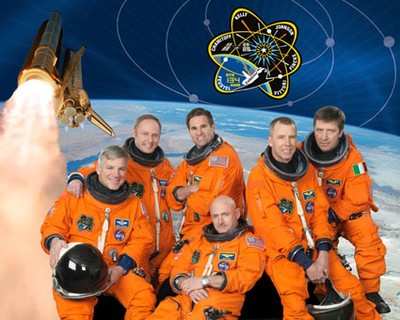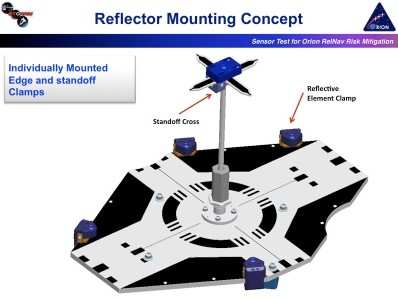Sixteen Day Mission Set For Launch May 16
Endeavour's STS-134 mission to the International Space Station,
which is now scheduled for launch at 0856 EDT on May 16 and planned
for 16 days, will carry new spacecraft docking technology,
developed in part by NASA's Langley Research Center. The shuttle
will also deliver a particle physics detector, known as the Alpha
Magnetic Spectrometer-2 that will help researchers study the
formation of the universe. Endeavour also will transport a platform
that carries spare parts to sustain station operations after the
shuttles are retired from service. The mission will feature the
last four spacewalks by a shuttle crew.

The test-run of the state-of-the-art docking system, called the
Sensor Test for Orion Relative Navigation Risk Mitigation or
STORRM, will occur near the end of the mission. Its goal is to
validate new sensor and laser technology that will make docking and
undocking to the International Space Station (ISS) easier and safer
for astronauts. The shuttle crew will undock from the ISS and then
re-rendezvous, using the new technology. Langley engineers will be
in Houston to monitor the experiment.
STORRM hardware includes a Vision Navigation System (VNS) and a
high-resolution docking camera. The VNS is an eye-safe remote laser
sensing system that provides an image of the target – in this
case, the ISS – along with range and bearing data to precise
accuracies. The docking camera is designed to provide
high-resolution color images. Both these sensors will provide
real-time three-dimensional images to the crew with a resolution 16
times higher than the current shuttle sensors.
Much like the technology that allows automobiles to
parallel-park themselves without driver assistance, the VNS and
docking camera would allow the spacecraft to "park" itself. This
technology can also aid in hazard avoidance, allowing for safe
approach and landing on asteroids and other planetary surfaces.
"Engineers from industry and NASA overcame significant schedule and
technical challenges to make the STORRM project a reality," said
Frank Novak, STORRM project manager from NASA Langley. "Langley
designed a radiation tolerant data storage system in six months,
capable of storing one terabyte of data."

STORRM Mount Drawing NASA Image
Another group from Langley, the Hypersonic Thermodynamic
Infrared Measurements or HYTHIRM team, will keep an eye
specifically on the heat of the shuttle's re-entry into Earth's
atmosphere, scheduled for 0230 EDT June 1. They're working to
improve computer models and designs for future spacecraft thermal
protection systems. The team has been successful in acquiring
calibrated thermal "snapshots" of re-entry, ranging from Mach 8.5
to Mach 18, during six previous shuttle missions.
The team works with a Navy aircraft that flies under the shuttle
so the crew can use a special infrared optical system to record
Endeavour's heat signature during re-entry. The Navy NP-3D Orion
aircraft and the long-range infrared optical system are called
"Cast Glance" and are operated by the NAVAIR Weapons Division, Pt.
Mugu, CA. At closest approach, the aircraft will be approximately
25-40 miles from the shuttle. Because the orbiter is banking on
descent the plane will not be directly under it. Mission planners
say the aircraft location and flight maneuvers have been carefully
calculated to ensure safety to the shuttle and the respective
crews.
A team from NASA Langley will be in mission control during
re-entry to collect the most up-to-date shuttle re-entry
information and make recommendations to the P-3 flight crew so it
can make adjustments to the camera settings and aircraft position
for the best viewing. The data will be recorded and downloaded
after the P-3 Orion returns to its base of operations.
 ANN's Daily Aero-Linx (04.13.24)
ANN's Daily Aero-Linx (04.13.24) ANN's Daily Aero-Term (04.13.24): Beyond Visual Line Of Sight (BVLOS)
ANN's Daily Aero-Term (04.13.24): Beyond Visual Line Of Sight (BVLOS) Airborne 04.09.24: SnF24!, Piper-DeltaHawk!, Fisher Update, Junkers
Airborne 04.09.24: SnF24!, Piper-DeltaHawk!, Fisher Update, Junkers Aero-News: Quote of the Day (04.14.24)
Aero-News: Quote of the Day (04.14.24) ANN's Daily Aero-Term (04.14.24): Maximum Authorized Altitude
ANN's Daily Aero-Term (04.14.24): Maximum Authorized Altitude




